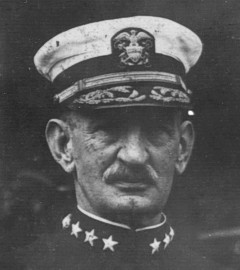
The best, the ablest, and the most competent of all the flag officers of the United States Navy down to the end of World War I. The restrained and judicious Mayo was the ideal superior, for he was a quiet man of remarkable ability.
— Fleet Admiral Ernest J. King, Aid to Admiral Mayo during WWI.
Born at Burlington, Vermont, he was graduated from the U.S. Naval Academy in 1876. He served during the 1883 Greely relief expedition to the Arctic and acted as navigator of the hydrographic vessel Bennington from 1895–98, during which time he helped survey Pearl Harbor.
Promoted to command divisions of the Atlantic Fleet in 1913, Mayo was instrumental in requesting and requiring from Mexico a formal public apology for the actions of Mexican authorities in seizing an unarmed U.S. party of sailors while ashore at Tampico on 9 April 1914 (the so-called Tampico Incident). Mexico’s refusal to accede to the U.S. demand for an apology led to President Wilson’s instruction to seize the Mexican customs house at Vera Cruz. This in turn led to the fall from power of the Mexican dictator General Victoriano Huerta.
In 1916 Mayo was given full command of the Atlantic Fleet and promoted vice admiral, a post he held throughout American involvement in World War I. He traveled to London in August 1917 to discuss Allied naval co-operation and was an advocate of a convoy anti-submarine policy as well as the construction of the Northern Barrage anti U-boat minefield. For his achievements, Admiral Mayo was awarded the Distinguished Service Medal for the outstanding operation of the US Atlantic Fleet in wartime.
Following the war, Vice Admiral Mayo served as Chairman of the U.S. Navy’s General Board—where he was a proponent of smaller warship construction—until his retirement in 1920. He was promoted to full admiral on the retired list in 1930.
He died in 1937.
Source: Naval History & Heritage Command including Dictionary of American Naval Fighting Ships.